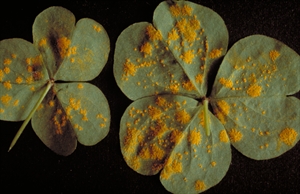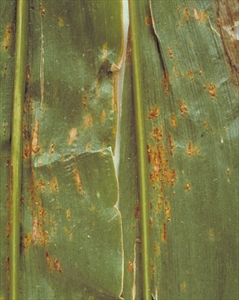Common rust (Puccinia sorghi)
Pacific Pests, Pathogens, Weeds & Pesticides - Online edition
Pacific Pests, Pathogens, Weeds & Pesticides
Maize common rust (225)
Puccinia sorghi (also known as Puccinia maydis). Another rust affects maize in the region, American corn rust or southern rust, Puccinia polysora (see Fact Sheet no. 42).
Puccinia sorghi: Asia, Africa, North, South and Central America, the Caribbean, Europe, Oceania. It is recorded from Australia, Cook Islands, Fiji, New Caledonia, New Zealand, Papua New Guinea, and Vanuatu.
Puccinia polysora: Asia, Africa, North, South and Central America, the Caribbean, Oceania. It is more common in the tropics than Puccinia sorghi, especially at lower altitudes. It is recorded from American Samoa, Australia, Fiji, New Caledonia, Papua New Guinea, Samoa, Solomon Island, Tonga, and Vanuatu.
Puccinia polysora - maize and some grasses. Note, there is no alternate host for this rust and it lacks those stages that occur on Oxalis.
Puccinia sorghi - maize and Oxalis species (wood sorrel). This rust has two unrelated hosts, and different spore-producing stages occur on each. The sexual stages occur on Oxalis (Photo1).
Note, Puccinia sorghi does not infect sorghum!
Puccinia sorghi - circular pustules, powdery, brown becoming brown-black as the plant matures (Photo 2). The pustules occur on all above-ground parts, but are most common on the leaves where they are scattered on both surfaces. In severe cases, the leaves and leaf sheaths turn yellow and die early.
Puccinia polysora - small circular to elliptical, reddish brown pustules (0.2-2 mm) occur well distributed over the upper surface of leaves. Severely affected leaves die early. Pustules produced on the midribs and leaf sheaths are larger than those on the leaves and are irregular in shape. The rust is most severe on the lower leaves.
Both these rusts produce 'urediniospores' that recycle the disease within and between maize crops. In tropical countries, where maize is grown year-round, repeated cycles of urediniospores spread both these rusts from older to younger plants. Additionally, both rusts also produce another spore type, 'teliospores', which are dark with thick walled. However, teliospores are probably not important in survival and spread of Puccinia polysora; and with this rust there is no other host.
In regions where Puccinia polysora does not survive throughout the year, spores (urediniospores) are blown in from regions where it does survive. This is the situation in the USA. Survival and spread of Puccinia sorghi, in contrast, is more complex: it may be blown in from regions where it survives throughout the year (e.g., to the USA), or it may survive as teliospores, germinating to form other spore types and completing the life cycle on Oxalis species, which forms spores that infect maize (e.g. in India) - all within the same country.
Warm wet weather favours the diseases caused by these rusts. Temperatures in the range of 16-23°C are best for Puccinia sorghi, and 20-30°C for Puccinia polysora.
Puccinia sorghi has caused severe damage to susceptible maize varieties in the past, limiting production in tropical countries, but the threat has largely been overcome by resistant varieties. Puccinia sorghi is not now considered a problem on maize, but it is on sweet corn, especially in temperate countries where plantings throughout spring and summer overlap, and late season plantings are severely affected. In the tropics, Puccinia sorghi occurs more commonly above 1000 masl.
Puccinia polysora has also caused severe epidemics in Africa as well as the US and the Philippines. It occurs in the sub-tropics and tropics, and is favoured by higher temperatures than Puccinia sorghi.
Both rusts produce similar symptoms and they are difficult to tell apart. To make it even more difficult, they can occur together on the same plant. When alone on a plant, pustules of Puccinia sorghi form in about equal numbers on both sides of the leaf, while those of Puccinia polysora form primarily on the top surface. The pustules of Puccinia sorghi are darker and more round than those of Puccinia polysora, which are more oval to irregular in shape. Also, Puccinia polysora is more common on maize in the tropics, especially at lower altitudes, less than 1000 masl.
Microscopic examination is required to see the size of the urediniospores and the thickening of the walls of the teliospores. A molecular test has been developed to identify each of these rust species.
CULTURAL CONTROL
Maize rusts are generally controlled by the use of resistant maize hybrids, and by foliar applications of fungicides on sweet corn. Cultural practices may be effective in areas where rust spores can overwinter on debris or where infected Oxalis species are a source of spores. Therefore, collect the remains of the crop and destroy by burning or burying, and weed around maize plots if Oxalis is common. Destroy 'volunteer' maize plants before planting new crops.
RESISTANT VARIETIES
The use of resistant varieties is the best way of managing rust diseases. Two types of resistance exist: partial resistant and qualitative resistance. Partial resistance (or tolerance) results in fewer pustules, reduced sporulation, and lower germination rates. Disease spread and the development of epidemics are slower. Qualitative resistance is based on single genes providing total resistance. The trouble with this kind of resistance is that it may encourage the selection of new strains of the rust that can overcome varietal resistance.
CHEMICAL CONTROL
Fungicides have been used against both common and southern rust, but they are usually not needed in maize because of the resistance bred into commercial varieties. However, foliar fungicides may have a use on sweet corn. A number of protectant fungicide have been recommended: e.g., chlorothalonil and mancozeb. Plants are monitored and sprays commence when there are on average six pustules per leaf.
____________________
When using a pesticide, always wear protective clothing and follow the instructions on the product label, such as dosage, timing of application, and pre-harvest interval. Recommendations will vary with the crop and system of cultivation. Expert advice on the most appropriate pesticide to use should always be sought from local agricultural authorities.
AUTHOR Grahame Jackson
Information from CABI (2015) Puccinia sorghi (common rust of maize), and CABI (2013) Puccinia polysora (American corn rust) Crop Protection Compendium. (https://www.cabi.org/cpc/datasheet/45872) and (https://www.cabi.org/cpc/datasheet/45850), respectively; and from McKenzie E (2013) Puccinia sorghi: PaDIL - http://www.padil.gov.au. Photos 1&2 Kohler F, et al. (1997) Diseases of cultivated crops in Pacific Island countries. South Pacific Commission. Pirie Printers Pty Limited, Canberra, Australia.
Produced with support from the Australian Centre for International Agricultural Research under project PC/2010/090: Strengthening integrated crop management research in the Pacific Islands in support of sustainable intensification of high-value crop production, implemented by the University of Queensland and the Secretariat of the Pacific Community.





